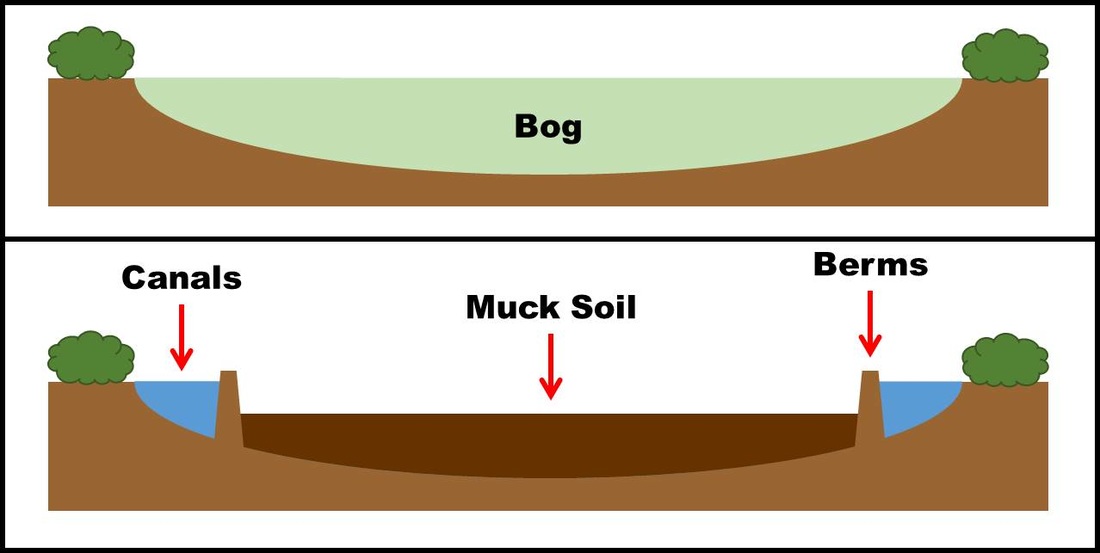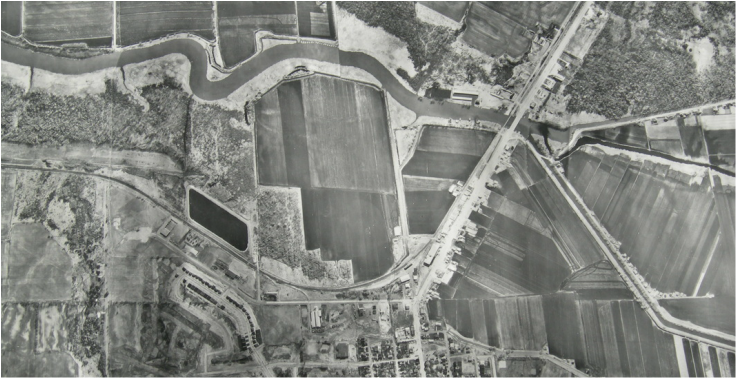|
A polder is an area of low-lying land that has been reclaimed from a body of water and is protected by dyke and pump systems. Once the land to be reclaimed has been selected, dykes are built around the area. The water within the dykes is then pumped out of the area into a system of constructed canals (Figure 1). The land remaining is below the natural water level and pumps are used to continually remove water from the area. The polder is physically separate from the surrounding water system as the inflow and outflow are controlled through pumping stations. Natural seepage from ground water also contributes to maintaining soil moisture. The Dutch are well-known for their polders. They have reclaimed sea beds using this technique, holding back the sea with large dyke systems and pumps that were once powered by windmills. Other polders can be built to reclaim land from lakes, rivers, or bogs. Rich, fertile soils reside within these polders; once drained, polders have clay or muck soils, or a combination of the two. The land is largely flat and treeless, which is very suited to agriculture. Draining the Holland Marsh, named for the first Surveyor General of Upper Canada Major Samuel Holland, was a project led by Professor William Day of the Ontario Agricultural College beginning in 1925. The 28 km of canals dug then now protects 7,000 acres of prime muck soil. Pumping stations, one situated at the North Branch and the other at the northern end keep the water level low enough to keep the land dry. There is an additional 2,500 acres in smaller polders along the Holland River as it runs north to Lake Simcoe.
1 Comment
Branden
8/20/2022 05:49:16 am
I notice the aerial picture of the marsh is covering the town of Bradford and the bridge leading to Newmarket, you can see the train tracks bridge adjacent to the other bridge, I would love to know the year of this and get a better zoom in because the house I grew up in is in this photo
Reply
Leave a Reply. |
Project UpdatesFind articles on project-related topics here Archives
December 2016
Topics
All
Article TitlesIntroduction to
Watersheds Lake Simcoe Watershed Nottawasaga Valley Watershed South-Eastern Georgian Bay Watershed Water, Water, Everywhere? The Trouble with Muck: Size Lesson Learned: Bottom- up Aerator to Treat Washwater in Settling Tanks Phosphorus, the Environment, and Farming Nitrogen’s Impact on Air, Land, and Water Water-borne Pathogens and Food Safety Defining Dissolved Oxygen Filter Bags Demonstration Site Organic Matter Breakdown & Biochemical Oxygen Demand Dealing with Cloudy Water Hydrocyclone Demonstration Test What IS Muck? Demystifying Oxidation- Reduction Potential News Release "Technology Investigation: Filter Bags" Drum Filter Demonstration Site Decomposing With(out) Oxygen Flow monitoring Lesson Learned: Drum Filter Optimization Polders & the Holland Marsh Vegetable Washing Process Dry Soil Removal Ultrafiltration & Deionization Demonstration Site News Release "Technology Investigation: Ultrafiltration & Capacitive Deionization" Progressive Passive Filtration Dissolved Air Flotation Clarifying the Solid Removal Process Factsheet Reading Order News Release: "Technology Investigation: Coagulation & Flocculation" Self-Indexing Filter Monitoring Discharge Flows Settling Soil Mass Loading Calculations Lesson Learned: Technology Selection Electrocoagulation Auto-Samplers |


 RSS Feed
RSS Feed
